One inch for every two feet.
That’s how much the home foundation movement is acceptable. Home foundations move and as we will see in this blog, there is acceptable movement and unacceptable movement.
But, first, there are two forms of foundation movement that most homes experience: uniform and differential settlement.
- Uniform settlement. The home foundation settles slightly into the ground after construction. It should be the same across the entire home. An uneven settlement should cause concern.
- Differential settlement. Sections of your home settle at uneven rates. Signs of this include drywall cracks, cracked floors, foundation cracks, and windows and doors that are sticking.
Causes of the home foundation movement include
- Extensive digging. Too much soil is removed around the foundation. Thus, it has very little support. This mainly occurs in basements.
- Weather changes. Extreme weather conditions from dry soil to wet soil cause it to sink in sections. Flooding can disperse soil from under the foundation.
- Expansive soil. This soil expands and shrinks based on how much water saturates the dirt.
There are ways to conduct home repair foundations when this type of settlement occurs. Here are a few different ways to fix the home foundation movement.
- Helical piers. These lift settling foundations. They are pushed into the soil around the foundation and twisted until they reach their highest load-bearing limit.
- Helical tieback anchors. Beams are twisted into the dirt from inside the basement. When twisted, they pull the wall back outward.
- Carbon fiber repair. Carbon is used to straighten bowing walls and close foundation cracks. It’s a strong material and is almost unbreakable.
- Steel push piers. These are pushed under the foundation soil until they are strong enough to support the home’s weight. Then, hydraulic jacks are attached to the foundation sides and pushed down on the piers. This pressure lifts the home.
- Compaction grouting. Polyurethane foam is injected into loose soil underneath the foundation. The foam expands and hardens. It forms balls or columns of dense structural supports. The process compacts the weak soil.
- Permeation grouting. Cement is injected underneath the foundation. This injection fills gaps in the soil and compacts the weak soil into a solid mass.
- Wall plate anchors (for concrete block walls). If the basement and foundation walls are bowing, home foundation repair technicians use wall plate anchors that are inserted inside the bowing wall. The anchor is placed in a trench and the steel beam is slipped through the plate, wall, and dirt until it meets with the anchor outside. Once they connect, the plates are torqued, pulling the wall out and stopping to correct the movement.
M Taylor Enterprise can inspect your home foundation to see if you have any basement waterproofing issues. Call our home foundation and structural repair experts in Maryland at (301) 649-3406 or matt@mtaylorenterprise.com. We will do a free consultation, make recommendations then do any needed repairs quickly and efficiently.
We serve Montgomery County, MD, parts of Prince Georges, MD, and Howard County, MD.






